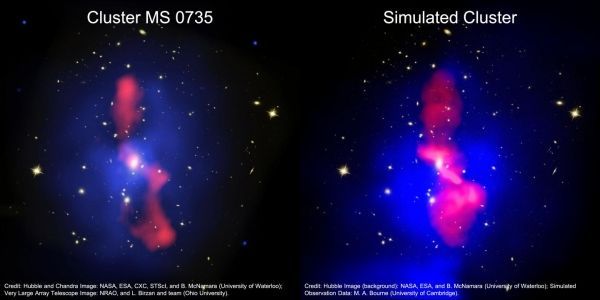“Weather” in clusters of galaxies may explain a longstanding puzzle, according to a team of researchers at the University of Cambridge. The scientists used sophisticated simulations to show how powerful jets from supermassive black holes are disrupted by the motion of hot gas and galaxies, preventing gas from cooling, which could otherwise form stars. The team publish their work in the journal Monthly Notices of the Royal Astronomical Society.
Typical clusters of galaxies have several thousand member galaxies, which can be very different to our own Milky Way and vary in size and shape. These systems are embedded in very hot gas known as the intracluster medium (ICM), all of which live in an unseen halo of so-called ‘dark matter’.
A large number of galaxies have supermassive black holes in their centres, and these often have high speed jets of material stretching over thousands of light years that can inflate very hot lobes in the ICM.
Read more at: Royal Astronomical Society
The left hand panel shows an actual observation of the galaxy cluster MS 0735.6+7421, while on the right the background Hubble image has instead been overlaid with a mock observation of the jet (pink) and X-ray emission (blue) made from the simulation. Both images show cavities excavated by the lobe inflation surround by X-ray bright rims of dense gas (blue), which are filled by distorted jet material (pink) (Photo Credit: Hubble and Chandra Image: NASA, ESA, CXC, STScI, and B. McNamara (University of Waterloo); Very Large Array Telescope Image: NRAO, and L. Birzan and team (Ohio University); Simulated Data: M. A. Bourne (University of Cambridge).


